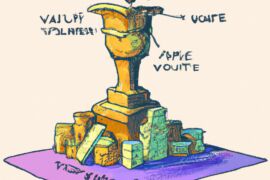Value investing is an art, a science, and a philosophy rolled into one. This tried-and-true investment strategy involves identifying and buying stocks that appear underpriced compared to their intrinsic value. Rooted in the principles laid out by legendary investors like Benjamin Graham and Warren Buffett, value investing isn’t about quick trades and instant profits.

Brief Explanation of Value Investing
Instead, it’s a long-term game, a strategy of patience, discipline, and diligent research, waiting for the market to recognize the true value of a stock and adjust its price accordingly. Value investors are the detectives of the investment world, searching for clues in financial statements, market trends, and economic indicators to identify stocks that others have overlooked.
In this treasure hunt for undervalued stocks, a value investor is equipped with several tools, one of which is the Price-to-Tangible-Book (P/TB) ratio. Often overshadowed by its more famous cousin, the Price-to-Book (P/B) ratio, the P/TB ratio is a less frequently used but equally potent tool. It’s the hidden gem in the value investor’s toolkit, offering unique insights that can make all the difference between an average investment and a great one.
Introduction to the Price-to-Tangible-Book (P/TB) Ratio
The P/TB ratio measures a company’s market price in relation to its tangible book value – that is, the net value of its physical assets, such as buildings, machinery, and inventory, after all its liabilities have been subtracted. Unlike the P/B ratio, the P/TB ratio excludes intangible assets like patents, copyrights, and brand value. In essence, it offers a more concrete perspective of a company’s value by focusing solely on hard, physical assets that can be seen, touched, and, most importantly, sold off in the event of a financial meltdown.
In this journey through the unchartered territories of the P/TB ratio, we will explore its significance, decode its calculation, and investigate its role in uncovering potential investment opportunities. This article will serve as your compass, guiding you to navigate and harness the power of the P/TB ratio in your value investing strategy. We’ll delve into the historical relevance of the P/TB ratio, illustrate its application using real-world examples, compare it with other popular valuation metrics, and even try to glimpse into its future in value investing.
As we embark on this journey, let’s remember that like any other tool, the P/TB ratio is neither a magic wand nor a crystal ball. It does not guarantee success, and it does not predict the future. But it does provide a fresh perspective, a different lens to view potential investments. And sometimes, that’s all it takes to spot a diamond in the rough.
Understanding the Price-to-Tangible-Book Ratio
Definition and Formula for the P/TB Ratio
Firstly, let’s unpack what we mean by the Price-to-Tangible-Book (P/TB) Ratio. It sounds like a mouthful, but once you get to know it, it’s more like a trusted friend, a fellow explorer in the wilderness of financial analysis. In essence, the P/TB ratio is a financial metric that compares a company’s market capitalization (the price) to its tangible book value. If we were to distill it into a formula, it would look something like this:
P/TB ratio = Market Capitalization / Tangible Book Value
This elegant equation allows you to gauge whether a company’s stock price adequately reflects the value of its tangible assets, those you can touch, see, and sell, offering an opportunity to discern the undervalued from the overpriced.

Explanation of Each Variable: Price, Tangible Book Value
Now, let’s dissect the components of this equation. The numerator, Market Capitalization, is simply the current market price of a company’s share multiplied by the number of outstanding shares. It’s the public’s current verdict on a company’s worth.
The denominator, Tangible Book Value, is a bit more complex. To calculate it, we start with the company’s total assets (everything it owns), subtract total liabilities (everything it owes), and then subtract intangible assets (assets without physical substance like patents and goodwill). The result? A value that represents the net physical assets of a company, or in other words, what shareholders could theoretically lay their hands on if the company was liquidated.
Comparison to Price-to-Book (P/B) Ratio
If the P/TB ratio were an actor, it would be the character actor, the unsung hero of the financial world, doing the vital work while its cousin, the Price-to-Book (P/B) ratio, often grabs the limelight. The P/B ratio is similar to the P/TB ratio, but it includes both tangible and intangible assets in the denominator. This might seem like a small difference, but it can drastically change the outcome, especially in companies where intangible assets like intellectual property or brand recognition play a large role.
Why the P/TB Ratio Matters: Focusing on Tangible Assets
Why focus on the P/TB ratio and not the more popular P/B ratio? Well, while intangible assets can add substantial value to a company, they can also be nebulous, hard to value, and don’t necessarily translate into hard cash in times of trouble. The P/TB ratio, on the other hand, offers a more conservative, down-to-earth view of a company’s worth by focusing solely on tangible assets. This can be particularly useful in certain industries or during economic downturns when the tangibility of assets becomes paramount.
In a nutshell, the P/TB ratio is a bit like a miner’s sieve, filtering out the shiny but often deceptive fragments of intangible assets, and leaving behind the real gold nuggets – the tangible assets. It’s this ability to focus on the tangible, the real, and the concrete, that makes the P/TB ratio such a potent tool in the value investor’s arsenal.
source: TheStreet on YouTube

Historical Context of P/TB Ratio
Emergence and Evolution of the P/TB Ratio
The Price-to-Tangible-Book (P/TB) ratio might not be the eldest child in the valuation metric family, but it does have a rich and intriguing history. Born out of the ashes of the dot-com bubble in the late 90s and early 2000s, when companies with vast intangible assets but little actual physical value collapsed, it served as a sobering reminder of the importance of tangible assets in a company’s value.
Over the years, the P/TB ratio has morphed, adapted, and evolved, quietly finding its place in the financial toolboxes of savvy investors who understood its unique utility. It was no longer about the charm of the new economy businesses with their flashy intangible assets; instead, the focus shifted back to the age-old fundamentals of businesses – their tangible assets.
Past Market Scenarios Where P/TB Was Notably Effective
The P/TB ratio really shone in the wake of the 2008 global financial crisis. In the midst of the market’s turmoil and confusion, many companies saw their stock prices plummet, while their tangible book values, especially in sectors like manufacturing, utilities, and energy, remained relatively steady. Astute investors using the P/TB ratio could sift through the wreckage and identify these undervalued diamonds in the rough, which provided substantial returns once the market rebounded.
Again, during the economic uncertainty caused by the COVID-19 pandemic, the P/TB ratio emerged as a solid guide for value investors. As companies faced unprecedented challenges, the ability to differentiate those with solid tangible assets from those propped up by intangibles was invaluable. The P/TB ratio became a guiding light in the storm, helping to distinguish the fleeting from the enduring.
Changing Relevance of P/TB Ratio in Different Market Conditions
The P/TB ratio is like a chameleon, subtly changing its relevance based on the market landscape. In bull markets, when optimism reigns and intangibles like brand value and intellectual property can inflate stock prices, the P/TB ratio serves as a reality check, grounding assessments in the solid foundation of tangible assets.
On the other hand, in bear markets, where pessimism rules and companies are often undervalued, the P/TB ratio can identify stocks that have been oversold and are ripe for investment. It’s like a trusty compass, always pointing towards tangible value, regardless of the market’s mood swings.
However, it’s important to remember that like all financial ratios, the P/TB ratio doesn’t exist in a vacuum. Its effectiveness and relevance are shaped by the broader economic context, industry norms, and company-specific factors. It’s not a crystal ball, but it does offer a historical mirror reflecting the importance of tangible assets in valuing a company. Whether you are battling through a bear market or cruising in a bull market, the P/TB ratio remains a steadfast ally in the journey of value investing.
source: Edspira on YouTube

The Importance of the P/TB Ratio in Value Investing
How Value Investors Use the P/TB Ratio
The P/TB ratio plays the role of an unsung hero in the narrative of value investing. Value investors, in their quest for undervalued stocks, use the P/TB ratio like a divining rod, seeking out those companies whose market prices do not do justice to their underlying tangible assets. When the P/TB ratio of a company is significantly lower than its industry average or its historical norms, it can signal that the company’s shares are undervalued.
However, a low P/TB ratio isn’t an automatic green light for investment. Instead, it’s an invitation to dig deeper, to understand why the market is discounting these tangible assets. Is it temporary market pessimism or are there genuine concerns about the company’s profitability or asset quality? By provoking these questions, the P/TB ratio opens the door to further analysis, serving as a launching pad rather than a landing zone for investment decisions.
Case Studies of Successful Investments That Used the P/TB Ratio
Let’s delve into the history books for a moment and revisit the global financial crisis of 2008. Amidst the chaos and panic, many solid companies were unfairly punished, their market prices falling much more than their tangible book values. Take the example of a certain global leader in the manufacture and sale of construction and mining equipment. The company saw its P/TB ratio plunge, but their tangible assets remained strong. Savvy investors who spotted this discrepancy and invested were rewarded handsomely when the market rebounded.
In another instance, during the COVID-19 pandemic, a renowned airline company’s shares plummeted as travel came to a standstill. However, the company’s tangible assets, which included a large fleet of aircraft, offered a safety net. Investors who used the P/TB ratio to identify this opportunity and had the courage to invest during the crisis saw substantial returns once the travel industry began to recover.
Comparisons to Other Financial Ratios Used in Value Investing
While the P/TB ratio is a valuable tool, it’s not the only one in the value investor’s toolkit. Other ratios, such as the Price-to-Earnings (P/E) ratio and the Price-to-Book (P/B) ratio, also play crucial roles. The P/E ratio can give insights into a company’s earnings potential, while the P/B ratio, which includes intangible assets, can be useful for companies in sectors where intangible assets are key value drivers.
However, in situations where the earnings are volatile, or the worth of intangible assets is questionable, the P/TB ratio comes to the rescue. Its focus on tangible assets offers a firm foundation in an uncertain world, a safety net in times of economic upheaval. Like the dependable friend who shows up in times of need, the P/TB ratio is a trustworthy companion for the discerning value investor, highlighting opportunities that others might miss.
source: The Investing for Beginners Podcast on YouTube

How to Calculate the P/TB Ratio
Step-by-step Guide to Calculating the P/TB Ratio
Roll up your sleeves and put on your thinking caps because it’s time to do some financial math. Don’t worry, calculating the P/TB ratio is simpler than it sounds. It’s a bit like baking a cake. You just need the right ingredients and the proper method. Here’s a step-by-step guide:
- Identify the company’s market capitalization: This is the total dollar value of a company’s outstanding shares of stock. It’s calculated by multiplying the current market price per share by the total number of outstanding shares.
- Calculate the tangible book value: Start with the company’s total assets, subtract total liabilities, and then subtract intangible assets. The resulting number is the tangible book value.
- Divide the market capitalization by the tangible book value: The result is the P/TB ratio.
List of Needed Financial Data and Where to Find It
To whip up this financial delicacy, you need three main ingredients:
- Market Capitalization: You can find this number readily available on financial news websites, stock market apps, or the investor relations page of the company’s website.
- Total Assets and Total Liabilities: These figures are available in the balance sheet section of a company’s annual report or Form 10-K, which you can find on the company’s investor relations webpage or databases like the U.S. Securities and Exchange Commission’s EDGAR database.
- Intangible Assets: This is also available in the balance sheet, often listed under non-current assets. Examples include goodwill, patents, copyrights, and brand value.
Example Calculations Using Real-World Data
Let’s consider a hypothetical company, Alpha Industries. The current market price of Alpha Industries is $50 per share, and it has 100 million shares outstanding. This gives us a market capitalization of $5 billion.
Now, looking at their balance sheet, we see that their total assets amount to $6 billion, total liabilities are $2 billion, and intangible assets total $1 billion. Subtracting liabilities and intangible assets from total assets gives us a tangible book value of $3 billion.
Using our formula, we divide the market capitalization ($5 billion) by the tangible book value ($3 billion), resulting in a P/TB ratio of approximately 1.67.
Potential Pitfalls and Things to Be Careful About When Calculating
While calculating the P/TB ratio might seem like a walk in the park, it does require care. Remember, garbage in, garbage out. The accuracy of your P/TB ratio depends on the accuracy of your inputs.
Always ensure that you are using the most recent financial data. Markets are dynamic, and so are company financials. Using outdated data can lead to incorrect conclusions. Also, be careful when assessing intangible assets, as not all intangibles listed on the balance sheet may be of real value. For instance, goodwill, often a large component of intangibles, can sometimes be inflated or impaired, skewing your calculations.
Lastly, remember that the P/TB ratio isn’t a one-size-fits-all metric. It’s more useful in sectors like manufacturing, energy, and utilities, where tangible assets are key. In sectors like technology or pharmaceuticals, where intangible assets can drive value, the P/TB ratio might not paint a complete picture.
Calculating the P/TB ratio is a bit like assembling a jigsaw puzzle. Each piece of financial data has its place, and when they come together correctly, they reveal a comprehensive picture of a company’s valuation. It’s a meticulous task, but for the keen value investor, it’s a journey well worth taking.
source: Adam J. Mead – The Oracle’s Classroom on YouTube

Using the P/TB Ratio to Identify Investment Opportunities
Strategies for Using the P/TB Ratio to Find Undervalued Stocks
Unleashing the power of the P/TB ratio requires strategy, much like a chess game where the right moves can lead you to victory. Start by identifying sectors where tangible assets play a significant role in valuation, like manufacturing, utilities, and energy. Once you have your target sectors, filter companies with a lower P/TB ratio than their industry averages.
But remember, a low P/TB ratio is just the first clue. It’s the breadcrumb that leads you into the forest, but you’ll need more to find your way. Dig deeper into the company’s financials. Why is the market undervaluing its tangible assets? Are there concerns about asset quality or profitability? Does the company have a history of generating returns on its assets? Your quest for undervalued stocks using the P/TB ratio is a blend of detective work and financial analysis.
Case Studies of Companies That Currently Have Low P/TB Ratios
Consider the case of the Beta Materials Corp, a global materials company with a focus on base metals. While their recent earnings have been disappointing due to market conditions, their P/TB ratio has dipped below its historical average and the current industry average. Their assets, consisting of mines and plants, remain valuable and productive. Here, the P/TB ratio serves as an alert to a potential undervaluation, warranting further investigation into Beta Materials Corp.
In another instance, let’s examine Gamma Energy, a company in the utilities sector. Their P/TB ratio has dropped significantly due to a recent market sell-off, but their power generation infrastructure and other tangible assets remain as solid as ever. A deeper dive into their financials suggests the market reaction might be an overreaction, positioning Gamma Energy as an interesting prospect for the P/TB-focused investor.
Risks and Limitations Associated with Using the P/TB Ratio
While the P/TB ratio is a powerful tool, it’s not a magic wand. It has its risks and limitations. It’s most effective in sectors where tangible assets are central to the business model. Using it in sectors like technology or pharmaceuticals, where intangible assets can be the key drivers of value, might not yield accurate results.
Furthermore, a low P/TB ratio might not always signal an undervalued stock. It could also indicate issues with the company’s assets or profitability. For example, a company could have a low P/TB ratio because its assets are obsolete or its industry is facing a downturn.
Also, remember that the P/TB ratio is a static measure; it takes a snapshot of the company’s value at a certain point in time. It doesn’t consider the company’s future earnings potential or growth prospects.
So, like any seasoned sailor, while you navigate the vast oceans of investment opportunities with the compass of the P/TB ratio, remember to keep an eye on the winds and the waves, the changing market conditions and company-specific factors. The P/TB ratio is a powerful ally in your investment journey, but it needs to be used wisely and in conjunction with other financial tools for the best results.
source: The Plain Bagel on YouTube

P/TB Ratio in Comparison with Other Valuation Metrics
Comparing and Contrasting P/TB with P/E, P/B, and Other Popular Ratios
The world of investing is filled with ratios, each serving a specific purpose, much like the different tools in a well-stocked toolbox. Just like you’d use a wrench for bolts and a hammer for nails, different financial situations call for different ratios.
The Price-to-Earnings (P/E) ratio, for instance, focuses on a company’s earnings potential. It answers the question, “how much am I willing to pay for each dollar of the company’s earnings?” However, earnings can be volatile and subject to creative accounting practices.
The Price-to-Book (P/B) ratio, on the other hand, is a broader measure that compares a company’s market price to its total book value, including both tangible and intangible assets. It can be more effective for companies in sectors where intangible assets play a significant role, such as technology or pharmaceuticals.
The P/TB ratio, in contrast, is all about tangible assets. It’s like the trusty flashlight that reveals the real, physical value beneath the surface, untouched by intangibles or accounting trickery. For sectors where tangible assets are key, the P/TB ratio can shine a light on opportunities that other ratios might miss.
Advantages and Disadvantages of Using the P/TB Ratio
The P/TB ratio has the unique advantage of focusing on the hard, tangible assets of a company. This means it can be more resistant to accounting manipulations and can provide a ‘ground truth’ in situations where earnings are unstable or intangible assets are questionable. It’s the financial equivalent of having a firm hand to shake or a solid car to drive – there’s something reassuring about the tangibility.
However, the P/TB ratio also has its drawbacks. Its focus on tangible assets means it might overlook companies in sectors where intangibles drive value, potentially missing out on significant opportunities. Also, it can’t distinguish between different types of tangible assets – a dollar of cash is treated the same as a dollar of inventory, despite their very different liquidity and profitability profiles.
Discussing Situations Where P/TB Might Be Misleading
Like any financial metric, the P/TB ratio has its blind spots. For example, it might be misleading for companies in the process of significant business transformations, such as companies selling off assets or investing heavily in intangible assets.
Moreover, it can be misleading for companies with significant debt. The P/TB ratio doesn’t account for how a company’s assets are financed, so a highly leveraged company could appear attractive based on its P/TB ratio, even though its high debt levels pose significant risks.
And finally, remember that the P/TB ratio doesn’t consider the quality or profitability of a company’s assets. A company with a low P/TB ratio might not be a bargain if its assets are obsolete, underutilized, or generating poor returns.
The P/TB ratio, like any investing tool, is a mixed bag of strengths and weaknesses, of shining insights and hidden pitfalls. It’s a compass, not a GPS. It can help guide your investment journey, but the ultimate destination – a successful investment – requires a comprehensive analysis that goes beyond any single ratio.

Practical Application of P/TB Ratio
Exploring Various Sectors and How They Fare with P/TB Ratio Analysis
Venturing into the investment landscape with the P/TB ratio as your guide is much like exploring a vast and diverse continent. Each sector is like a unique biome, with its own rules, peculiarities, and treasures.
In the bustling industrial plains, companies are often heavy with tangible assets like factories, machinery, and inventory. Here, the P/TB ratio can be a valuable lens, revealing companies that the market might be undervaluing.
Venturing into the energy forests, where tangible assets such as oil reserves and power plants rule, the P/TB ratio can again be an effective guide, highlighting potential opportunities where the market might not fully appreciate the value of these substantial assets.
However, as you trek into the technology highlands, the terrain changes. Here, intangible assets like patents and software take precedence over tangible ones. While the P/TB ratio might still have some utility, its effectiveness could be limited.
And finally, as you journey into the financial services deserts, the P/TB ratio might not be your best tool. Financial companies’ balance sheets are dominated by financial assets, and their market values often reflect elements like earning assets, risk management, and future earnings potential more than their tangible book values.
Strategies for Incorporating P/TB Ratio in a Diversified Portfolio
Diversification is like a well-balanced meal – you need a mix of different food groups to stay healthy. The same is true for your investment portfolio. The P/TB ratio is a helpful tool for adding some value investing ‘protein’ to your portfolio ‘meal.
Begin by identifying sectors where tangible assets are a significant driver of value. Then, look for companies within these sectors that have a P/TB ratio lower than the industry average. Shortlist these companies for further investigation.
Remember, the P/TB ratio is just the first step. Dig deeper into the company’s financials, business model, competitive position, and management quality before making an investment decision. The aim is to balance your portfolio, not tilt it excessively towards low P/TB stocks.
Integrating P/TB Ratio with Other Financial Indicators for a More Holistic Investment Approach
The P/TB ratio, while powerful, is just one piece of the investment puzzle. Integrating it with other financial indicators can provide a more comprehensive view of a company’s value.
For example, combine the P/TB ratio with the P/E ratio to capture both a company’s tangible asset value and its earnings potential. Add in the Debt/Equity ratio to get a sense of how a company is financing its assets. Look at the Return on Assets (ROA) or Return on Equity (ROE) to understand how effectively a company is using its assets to generate profits.
The key to successful investing is not to rely on a single metric, but to develop a multi-faceted understanding of a company’s financial health, competitive position, and market valuation. Like a well-tuned orchestra, the best investment decisions come from considering a harmony of financial indicators, not just a solo performance. The P/TB ratio is a valuable player in this orchestra, but it’s the combined melody of all the financial instruments that creates the most insightful investment symphony.
The Future of P/TB Ratio in Value Investing
Trends Affecting the Importance and Use of P/TB Ratio
As we gaze into the crystal ball of the future of value investing, the role of the P/TB ratio is evolving in intriguing ways. We live in an era of rapid change, where innovation and disruption have become the norm. Companies that were once rooted in tangible assets are now harnessing the power of intangibles, like data, technology, and brand value.
In this shifting landscape, the P/TB ratio remains relevant, but its role is changing. It’s still invaluable for sectors where tangible assets are central, but as more value shifts towards intangibles, it may be less effective as a standalone measure. This doesn’t mean the P/TB ratio is becoming obsolete – far from it. Instead, it highlights the importance of using it judiciously, in tandem with other financial ratios, to paint a more holistic picture of a company’s value.
Technological Advancements and Their Impact on P/TB Ratio Calculations and Use
Technological advancements are reshaping the investment world. Big data and artificial intelligence are helping investors analyze financial information faster and more accurately than ever before. These tools can aid in the calculation and interpretation of the P/TB ratio, making it easier to identify potential investment opportunities.
Consider automated trading systems that can scan thousands of stocks in milliseconds to identify those with low P/TB ratios. Or consider AI-driven financial analysis platforms that can combine the P/TB ratio with other financial metrics to generate sophisticated investment recommendations.
While technology enhances the ease and speed of using the P/TB ratio, remember that it’s a tool, not a replacement for human judgment. It can point you in the right direction, but the final investment decision should always be grounded in a deep understanding of the company and its financials, something that no algorithm can fully replicate.
Potential Changes in Financial Regulation and Their Impact on the P/TB Ratio
Looking ahead, changes in financial regulation could also affect the P/TB ratio. For example, regulations that affect how companies report their tangible assets or value their intangibles could impact the P/TB ratio’s calculation and interpretation.
Consider potential changes in how companies report leased assets, or how they value assets like land or natural resources. These changes could affect the tangible book value, and hence the P/TB ratio. Therefore, it’s important for value investors to stay informed about regulatory changes and understand their potential impact on the P/TB ratio.
In the ever-evolving world of investing, the P/TB ratio stands like a trusted lighthouse, guiding value investors towards potentially undervalued companies. Its role might evolve with the changing landscape, but its essence remains unchanged – it’s a tool to uncover the hard, tangible value that lies beneath the market’s fleeting whims and speculations. As we venture into the future of value investing, the P/TB ratio remains a steadfast companion, its beam illuminating the path towards sound, value-driven investment decisions.
source: Kiwoon Learning on YouTube
Conclusion: P/TB Ratio’s Significance in Value Investing
As our journey through the world of the P/TB ratio comes to a close, let’s pause to reflect on the ground we’ve covered. We’ve seen how the P/TB ratio, a tool that hones in on the tangible heart of a company’s value, is a powerful ally for the value investor. We’ve walked through its definition, calculation, and application, and explored how it fits into the broader landscape of financial ratios.
This humble ratio, with its focus on hard, tangible assets, can be a beacon of clarity in a world where intangibles and market sentiment often cloud the true value of a company. Whether it’s uncovering undervalued gems in asset-heavy sectors or adding a dose of tangibility to a diversified portfolio, the P/TB ratio remains a sturdy tool in the value investor’s kit.
Using the P/TB Ratio for Identifying Investment Opportunities
Yet, like all tools, the P/TB ratio is not a magic wand. It’s a starting point, a guide, not an end in itself. It can spotlight companies that might be undervalued, but it’s up to you, the investor, to dig deeper. It’s a tool to filter opportunities, to reduce the vast universe of stocks to a manageable shortlist worthy of further analysis.
But remember, the P/TB ratio is just one voice in the chorus of financial indicators that should inform your investment decisions. It’s the harmony of these various voices, from P/E and Debt/Equity to ROE and beyond, that creates a symphony of insights, guiding you towards sound, value-driven investments.
Encouragement for Further Study and Application of the P/TB Ratio
So, dear investor, I encourage you to harness the power of the P/TB ratio. Explore it, apply it, test it, and learn from it. Dive into its nuances and complexities, understand its strengths and limitations, and learn to integrate it with other financial indicators.
But most importantly, use it as a compass to navigate the exciting landscape of value investing. Let it guide you towards companies that are backed by hard, tangible value, firms whose worth lies in more than just market sentiment or accounting wizardry.
Remember, the quest for value is not a sprint but a marathon. It requires patience, resilience, and a well-stocked toolkit. The P/TB ratio, this hidden gem of value investing, is a worthy addition to that toolkit. As you journey onwards, may it light your path towards profitable and prudent investment decisions.
Important Information
Investment Disclaimer: The content provided here is for informational purposes only and does not constitute financial, investment, tax or professional advice. Investments carry risks and are not guaranteed; errors in data may occur. Past performance, including backtest results, does not guarantee future outcomes. Please note that indexes are benchmarks and not directly investable. All examples are purely hypothetical. Do your own due diligence. You should conduct your own research and consult a professional advisor before making investment decisions.
“Picture Perfect Portfolios” does not endorse or guarantee the accuracy of the information in this post and is not responsible for any financial losses or damages incurred from relying on this information. Investing involves the risk of loss and is not suitable for all investors. When it comes to capital efficiency, using leverage (or leveraged products) in investing amplifies both potential gains and losses, making it possible to lose more than your initial investment. It involves higher risk and costs, including possible margin calls and interest expenses, which can adversely affect your financial condition. The views and opinions expressed in this post are solely those of the author and do not necessarily reflect the official policy or position of anyone else. You can read my complete disclaimer here.






